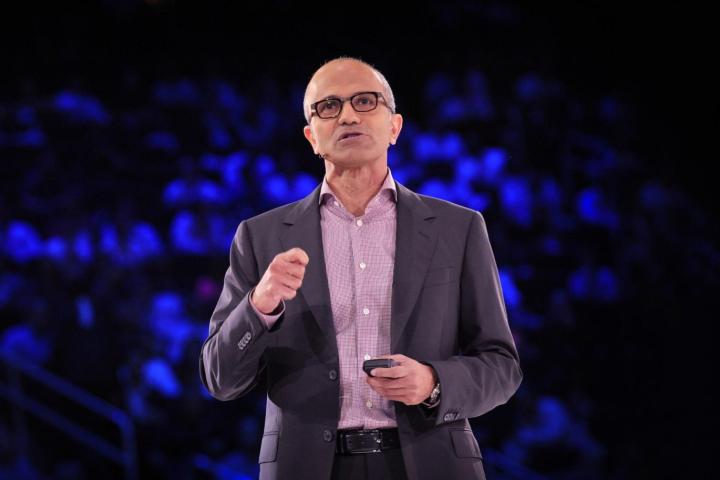
Update 2/4/14 9:29 a.m.: Satya Nadella has officially been hired as the new CEO of Microsoft, according to multiple reports.
The search for Microsoft’s next CEO is near its end. With Alan Mulally out, and rumors indicating that Stephen Elop is no longer a favorite, a new front-runner has emerged: Satya Nadella.
Though perhaps less well known than other names in the running for the spot, Nadella is an immensely qualified individual who’s been with the company for years and reportedly received the recommendation of outgoing CEO Steve Ballmer. But what might he do if he does indeed ascend to the throne?
Expanding the cloud
Satya Nadella is currently the head of Microsoft’s Cloud and Enterprise group, and that says a lot about his area of expertise. After starting his career at Sun Microsystems, Nadella joined Microsoft’s Online Services Division. He has many years of hands-on experience developing new cloud services for the world’s largest technology companies.
Nadella’s reputation seems pristine by Redmond’s standards.
That doesn’t mean he’ll ignore consumers. The Xbox One’s dedicated cloud is an example of how cloud services can be leveraged to support products in surprising ways, and we’d likely see more of that under Nadella’s regime. This could bolster the company’s Devices division, which has struggled to compete in every category it’s entered, with the sole exception of game consoles.
Improving consumer services
Besides expanding cloud-connected services, Microsoft must also refine and improve its existing products, most of which struggle to compete. SkyDrive and Office Web Apps aren’t bad, but they’re clearly behind the mind-share of Google Drive, which has become the default storage and productivity option for many consumers.

To combat this, the services offered by Microsoft must be better integrated with its various products. Office Web Apps, for example, could come installed as an app in every version of Windows, and Microsoft must more tightly integrate email and social media notifications into both Windows and Internet Explorer.
Nadella has a background in making similar initiatives successful. The swiftness with which he deployed Windows Azure and its cloud development tools could, if directed towards consumer services, take the company from zero to hero within a few years.
Connections are key
Microsoft’s failure to enhance Windows by leveraging features from other divisions seems puzzling at first glance, but makes sense in light of the company’s famous internal conflicts. Each division jealously guards its secrets for fear that releasing them might make the company a cannibal, eating the revenue of one division to fund another.
This is a huge problem, but Nadella is well equipped to solve it. As the head of the Cloud and Enterprise division, he already works closely with the other three divisions while developing services for Windows, Office and Xbox, so he has strong connections with colleagues across the company.
Since his Cloud and Enterprise Group is relatively new, he’s not connected with the decades-old conflict between Windows and Office. While any internal CEO candidate will inevitably have both friends and enemies within, Nadella’s reputation seems pristine by Redmond’s standards, which might help him execute Steve Ballmer’s vision of reforming Microsoft’s internal structure.
Engineering great software
While it’s arguable that Bill Gates was never among Silicon Valley’s greatest software engineers, his passion gave him a drive and focus that his successor lacked. Ballmer kept the revenue flowing, particularly in the enterprise market, but his grasp of product development was weak and led to the development of half-baked products that a product-focused CEO would’ve never allowed.
Nadella, like Gates, began his career as an engineer, and has a solid understanding of what’s required to develop and deploy new software and services. In his time at Microsoft, he has overseen development of new services like Windows Azure, Office 365 and the latest versions of Microsoft’s SQL Server.
A deeper understanding of the product side would be a boon, as Microsoft has repeatedly misjudged the consumer market in recent years. Nadella’s intimate knowledge of technology, and his background in developing it, would provide him – and thus, the company – with the foresight it lacked under Ballmer’s command.
Guiding the ship (without sinking it)
While many of Nadella’s assets lie within his skill set, there are traits he doesn’t possess which enhance his candidacy. He is not an outsider, a revolutionary, or an entrepreneur. In other words, he isn’t going to rock the boat, which is important.
Microsoft’s board is a conservative group, and any future CEO will have to take command of the company while also assuaging their concerns. An explosive new leader, no matter how charismatic, might meet resistance if he or she challenges the company’s core divisions, something Nadella is unlikely to do.
Microsoft needs a CEO who will guide divisions in the right direction instead of beating them into submission, and Nadella seems to be the right pick for that job. His calm demeanor, expertise and history with the company give him the qualities required to inspire change and cooperation in Redmond’s halls.
Salvation through Satya?
Satya Nadella seems to be one of the best candidates for the top job at Microsoft, and we hope the extensive rumors that he’ll soon receive the nod are true. His diplomatic nature and engineering experience are exactly what’s needed to reform the company into a quicker, more focused machine.
Editors' Recommendations
- Microsoft just teased its next big Windows 11 update
- Microsoft’s next Surface device could tackle Chromebooks directly
- Microsoft CEO would ‘welcome’ iMessage on Windows
- Project Reunion is Microsoft’s plan to fix its fragmented Windows app problem
- Why delaying the Surface Neo to 2021 was the only way Microsoft could save it

